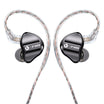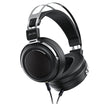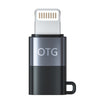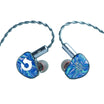Noise-cancelling headphones have exploded in popularity in recent years, thanks to advances in audio technology, making it easier to silence the world around us. They’re super handy for a range of situations, allowing you to listen to your music or podcasts in relative peace, whether you’re in a busy office or on a noisy aeroplane. With so many brands producing their versions of active noise-cancelling (ANC) headphones, it’s not hard to find one that will suit your taste, from over-ear cans to true wireless earbuds.
With so many different models on the market, making the right choice to meet your personal needs can be a headache. Price is a consideration since ANC headphones - generally costlier than their non-noise-cancelling counterparts - vary in price from budget-friendly to near excessive. This means that it pays to be informed on how the technology works and what kind of headphones or earbuds you should be considering.
That’s why we at Headphone Zone have put together this guide on everything you need to know about noise-cancelling headphones, from the different technologies used to give you some quiet, to the best noise-cancelling headphones you should buy.
What are noise-cancelling headphones?

Noise-cancelling headphones are headphones that either completely or partially block the ambient sound in your environment. So, if you’re walking outside and there’s a gusty breeze, you won’t hear the sound of the wind rushing past your ears quite as intensely as you would with a regular pair of headphones. You might not even hear it at all, depending on the level of noise cancellation applied.
Noise-cancelling headphones can decrease the sound of various noisy environments. Some can even dampen the low rumble in the cabin of an aircraft in flight. The amount of ambient noise these headphones can block depends on several factors, including the noise cancellation methods they use, their construction, and the loudness of your environment.
Passive Noise Cancellation Vs Active Noise Cancellation

Let’s talk about Passive Noise Cancellation. Known as Noise Isolation, this method does not cancel noise but reduces it to a great extent by isolating it. Passive Noise Cancellation is achieved by using soundproofing or isolation and insulation. Plush fitting earphones, over-ear headphones with heavily padded earpads, closed-back headphones or custom in-ear monitors are all examples of noise isolation techniques. If you feel that your current pair of in-ears let in noise, you can even use ear tips from Comply to achieve better noise isolation. Closed-back headphones with thick padding give excellent isolation. Though an effective method, noise isolation has a limit to how much it can cut out the noise. Looking for something more? Head over to Active noise-cancellation.
Active noise-cancelling headphones can do everything that passive ones can't do. In Active Noise-Cancellation technology, the headphone features a chip that ‘listens’ to noise and generates audio opposite to it in nature (also known as Pink Noise) and thus cancelling it. Sounds fancy? It’s just simple physics though, sound travels in waves, and these waves have characteristics like amplitude and phase, among other factors. Theoretically, if you fire a sound wave that is opposite in phase and of the same amplitude as an audio wave, you would cancel the original wave out. The noise cancellation tech takes care of the external noise. They also add an extra level of noise reduction by actively erasing lower-frequency sound waves. When I say active, it means using additional powered instruments.

Noise-cancelling technology is engineered to reduce distracting background noise, providing an exceptionally comfortable and restful listening environment in areas with high ambient noise.
Active noise-cancelling headphones have components like:
Microphone – Noise-cancelling headphones feature a miniature microphone in the earpiece that picks up ambient noise (traffic, air-handling systems, etc.)
Noise-cancelling circuitry – Electronics in the earpiece create a noise-cancelling wave that is 180° out of phase (or opposite) with the ambient noise. Result - It cancels out the annoying sounds that surround you without diminishing the audio you want to hear.
How does Noise-Cancellation help?

While noise-cancelling headphones do a good job distinguishing between the audio a user wants to hear and the background noise to keep out, some believe they compromise sound quality by muffling sounds. Also, the mechanism isn’t able to cut noises above 20dB. Ambient noises like aeroplane engines and closed trains are effectively cancelled, but louder noises cannot be affected by this technology as they would affect the audio performance of the headphone. Users can also experience a change in air pressure, although ports built into the ear cup are meant to vent air trapped behind the speakers.
If you are still thinking about getting a noise-cancelling headphones, make sure you spend some time with one first. Noise cancellation headphones are advanced, but they aren't magic. A lot of them require a bit of understanding to use. So take your time and find the perfect getaway to your wonderful land of music.






















































Leave a comment
This site is protected by hCaptcha and the hCaptcha Privacy Policy and Terms of Service apply.